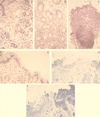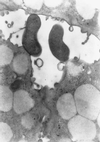A conventional beagle dog model for acute and chronic infection with Helicobacter pylori
- PMID: 10338528
- PMCID: PMC96629
- DOI: 10.1128/IAI.67.6.3112-3120.1999
A conventional beagle dog model for acute and chronic infection with Helicobacter pylori
Abstract
Helicobacter pylori has been widely recognized as an important human pathogen responsible for chronic gastritis, peptic ulcers, gastric cancer, and mucosa-associated lymphoid tissue (MALT) lymphoma. Little is known about the natural history of this infection since patients are usually recognized as having the infection only after years or decades of chronic disease. Several animal models of H. pylori infection, including those with different species of rodents, nonhuman primates, and germ-free animals, have been developed. Here we describe a new animal model in which the clinical, pathological, microbiological, and immunological aspects of human acute and chronic infection are mimicked and which allows us to monitor these aspects of infection within the same individuals. Conventional Beagle dogs were infected orally with a mouse-adapted strain of H. pylori and monitored for up to 24 weeks. Acute infection caused vomiting and diarrhea. The acute phase was followed by polymorphonuclear cell infiltration, interleukin 8 induction, mononuclear cell recruitment, and the appearance of a specific antibody response against H. pylori. The chronic phase was characterized by gastritis, epithelial alterations, superficial erosions, and the appearance of the typical macroscopic follicles that in humans are considered possible precursors of MALT lymphoma. In conclusion, infection in this model mimics closely human infection and allows us to study those phases that cannot be studied in humans. This new model can be a unique tool for learning more about the disease and for developing strategies for treatment and prevention.
Figures





Similar articles
-
Therapeutic vaccination against Helicobacter pylori in the beagle dog experimental model: safety, immunogenicity, and efficacy.Infect Immun. 2004 Jun;72(6):3252-9. doi: 10.1128/IAI.72.6.3252-3259.2004. Infect Immun. 2004. PMID: 15155627 Free PMC article.
-
[Animal models for the study of Helicobacter pylori infection].Postepy Hig Med Dosw (Online). 2014 May 15;68:603-15. doi: 10.5604/17322693.1102583. Postepy Hig Med Dosw (Online). 2014. PMID: 24864111 Review. Polish.
-
Animal models and vaccine development.Baillieres Clin Gastroenterol. 1995 Sep;9(3):615-32. doi: 10.1016/0950-3528(95)90051-9. Baillieres Clin Gastroenterol. 1995. PMID: 8563056 Review.
-
Experimental Helicobacter pylori infection induces antral gastritis and gastric mucosa-associated lymphoid tissue in guinea pigs.Infect Immun. 1998 Jun;66(6):2614-8. doi: 10.1128/IAI.66.6.2614-2618.1998. Infect Immun. 1998. PMID: 9596724 Free PMC article.
-
Gastric ulcers in SCID mice induced by Helicobacter pylori infection after transplanting lymphocytes from patients with gastric lymphoma.Gastroenterology. 1999 Oct;117(4):893-9. doi: 10.1016/s0016-5085(99)70348-3. Gastroenterology. 1999. PMID: 10500072
Cited by
-
Therapeutic vaccination against Helicobacter pylori in the beagle dog experimental model: safety, immunogenicity, and efficacy.Infect Immun. 2004 Jun;72(6):3252-9. doi: 10.1128/IAI.72.6.3252-3259.2004. Infect Immun. 2004. PMID: 15155627 Free PMC article.
-
The neutrophil-activating protein (HP-NAP) of Helicobacter pylori is a protective antigen and a major virulence factor.J Exp Med. 2000 May 1;191(9):1467-76. doi: 10.1084/jem.191.9.1467. J Exp Med. 2000. PMID: 10790422 Free PMC article.
-
Feline low-grade alimentary lymphoma: an emerging entity and a potential animal model for human disease.BMC Vet Res. 2018 Oct 11;14(1):306. doi: 10.1186/s12917-018-1635-5. BMC Vet Res. 2018. PMID: 30305106 Free PMC article. Review.
-
Immunohistochemical study of lymphocyte populations infiltrating the gastric mucosa of beagle dogs experimentally infected with Helicobacter pylori.Infect Immun. 2000 Aug;68(8):4769-72. doi: 10.1128/IAI.68.8.4769-4772.2000. Infect Immun. 2000. PMID: 10899885 Free PMC article.
-
A critical review on In Vivo and Ex Vivo models for the investigation of Helicobacter pylori infection.Front Cell Infect Microbiol. 2025 May 14;15:1516237. doi: 10.3389/fcimb.2025.1516237. eCollection 2025. Front Cell Infect Microbiol. 2025. PMID: 40438238 Free PMC article. Review.
References
-
- Ando T, Kusugami K, Ohsuga M, Shinoda M, Sakakibara M, Saito H, Fukatsu A, Ichiyama S, Ohta M. Interleukin-8 activity correlates with histological severity in Helicobacter pylori-associated antral gastritis. Am J Gastroenterol. 1996;91:1150–1156. - PubMed
-
- Axon A T R. The transmission of Helicobacter pylori: which theory fits the facts? Eur J Gastroenterol Hepatol. 1995;8:1–2. - PubMed
-
- Binhazim A A, Chapman W L, Shin S S, Hanson W L. Determination of virulence and pathogenesis of a canine strain of Leishmania infantum in hamsters and dogs. Am J Vet Res. 1993;54:113–121. - PubMed
Publication types
MeSH terms
Substances
LinkOut - more resources
Full Text Sources
Other Literature Sources
Medical

